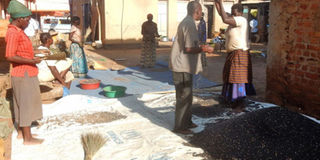Food shortage looms in north after poor harvest

Farmers remove chaff from beans in Lira Town yesterday. Researchers indicate that poor post-harvest practices can lead to food loss and also cause contamination of grains and beans with aflatoxins.
PHOTO BY BILL OKETCH
Lira- Ms Beatrice Ajok, just several households in Aleka Sub-county, Oyam District, grows maize, beans, soya beans and simsim (sesame) mainly for home consumption.
However, in recent months, Ms Ajok has suffered a decline in crop yields and post-harvest losses, finding it difficult to feed her five children.
In October, she only harvested 120kgs of beans from a two-acre garden, 80kgs of soya bean from a one-acre piece of land and 100kgs of maize from two acres.
The crop yields, Ms Ajok says, keep declining every year and currently, she says she cannot sell enough produce to meet their daily needs despite putting a lot of effort to prepare more planting land.
Ms Ajok’s experience reflects the increasing cases of food insecurity in northern Uganda due to post-harvest losses. More than 50 per cent of food is lost after harvest, raising fear of looming famine.
The National Agricultural Research Organisation (NARO) says many people face chronic hunger next year because of post-harvest losses. For instance, farmers in Pader District are losing about 60 per cent of the maize they produce.
Expert’s concern
Dr Laban Turyagyenda, the director of Ngetta Zonal Agricultural Research Development Institute, says drought caused by climate change has caused crop loss.
“Even what many farmers sell as produce is not produce; They are selling losses; they are selling moulded maize, moulded groundnuts. If they were to sort out and sell the original food, 80 per cent of the food would be lost,” Dr Turyagyenda says.
Researchers at NARO indicate that poor post-harvest practices can lead to food loss and also cause contamination of grains and beans with aflatoxins.
Studies supported by the Food and Agriculture Organisation (FAO) of the United Nations and the World Food Programme show a 10 per cent food loss resulting from poor post-harvest practices by farmers around the country.
“Actually, here in northern Uganda, we lose 50 per cent of food at post-harvest alone,” Dr Turyagyenda adds, warning that many Ugandans will go hungry if nothing is done. “In Uganda, one of the major challenges is the mindset. Even when farmers have got land, they think that going to town to work and earn Shs1,000 is better because they are looking at quick money,” Dr Turyagyenda says.
The agriculture expert says many Ugandans do not want to invest in agriculture through fertilizer application and weed management and yet they expect big harvest.
He adds other farmers have refused to embrace new, improved crop varieties that produce more yields.
“And we have a lot of improved varieties which can help them to increase their yields but they are stuck on their traditional food varieties. We are talking about people living in hunger but people here (in Uganda) have choices,” Dr Turyagyenda says.
However, Ms Molly Okello, a farmer in Ogur Sub-county, Lira District, argues that the traditional crop varieties are sweeter and more nutritious than the improved varieties.
But Dr Turyagyenda says the local varieties are prone to pests and diseases.
He adds that dependency syndrome is also keeping some people in abject poverty.
“A farmer has land and he’s even able to buy seeds but he’s waiting for handouts from government under the Operation Wealth Creation programme. Because of the government procurement issues, the procedure is rigid to avoid corruption and by the time they bring seeds for farmers, the rainy season is over,” he explains.
A 2017 state of food security report by FAO indicates that global hunger is on the rise, affecting 11 per cent of the global population.




